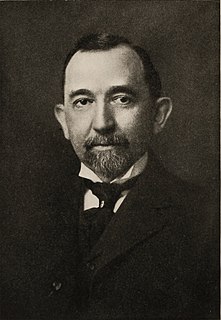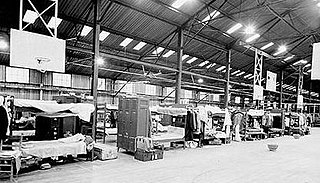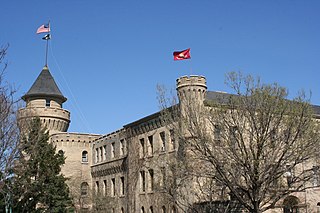
Duke University is a private research university in Durham, North Carolina. Founded by Methodists and Quakers in the present-day town of Trinity in 1838, the school moved to Durham in 1892. In 1924, tobacco and electric power industrialist James Buchanan Duke established The Duke Endowment and the institution changed its name to honor his deceased father, Washington Duke.

The University of North Carolina at Greensboro is a public research university in Greensboro, North Carolina. It is part of the University of North Carolina system. UNCG, like all members of the UNC system, is a stand-alone university and awards its own degrees. UNCG is accredited by the Southern Association of Colleges and Schools Commission on Colleges to award baccalaureate, masters, specialist and doctoral degrees. It is classified among "R2: Doctoral Universities – High research activity".

Trinity College is a private liberal arts college in Hartford, Connecticut. Founded as Washington College in 1823, it is the second-oldest college in the state of Connecticut.

Benjamin Newton Duke was an American tobacco, textile and energy industrialist and philanthropist. He served as vice-president at American Tobacco Company, being also founder of Duke Energy.

Carlow University is a private, co-educational, Catholic university located in the heart of Pittsburgh's "Tech, Ed, and Med" district. Founded by the Sisters of Mercy, Carlow's thirteen athletic teams are known as the Celtics, a reflection of the university's Irish heritage and roots. In 2017–2018, the student body is 84% women and 16% men.

Pfeiffer University is a private university in Misenheimer, North Carolina. It is affiliated with the United Methodist Church.

The Indoor Athletic Court was the home of North Carolina Tar Heels men's basketball team from January 8, 1924, through February 17, 1938, across fifteen seasons. Due to increased demand for viewing the varsity basketball team and limited capacity at then home court Bynum Gymnasium, the university appropriated $54,482.45 to have a structure built to house the team. Then Graduate Manager of Athletics Charles T. Woollen decided to build a temporary structure with those funds and a more permanent venue later. Plans were purchased and work began in October 1923. The building, which was a completely steel structure, was built with galvanized steel sheet siding and roof. Many felt the building did not have an attractive exterior. The building featured one bathroom, no locker or dressing rooms, and no heating system, initially. Quickly the building earned a reputation for being cold during the winter and hot during the summer time. An official heating system and, later individual heaters, were added to the building, but did not help the temperature problem. The men's basketball team moved to the Woollen Gymnasium in 1939.

Carter Gymnasium is a 947-seat multi-purpose arena in Buies Creek, North Carolina. It was previously home to the Campbell University Fighting Camels men's basketball and women's basketball teams. It was one of the smallest college basketball venues in Division I. The building was named for textile executive Howard Carter. Built in 1952 and opened in 1953, the dimensions of the basketball court are smaller than regulation, but a grandfather clause allowed Campbell University to continue its tenure in the division. The Fighting Camels began play in 2008 in the new John W. Pope, Jr. Convocation Center. The new $30 million arena seats 3,000 spectators for athletic events.

The College of Mount Saint Vincent (CMSV) is a Catholic liberal arts college in New York City. It was founded in 1847 by the Sisters of Charity of New York.

Alumni Hall is the on-campus basketball gymnasium at Providence College in Providence, Rhode Island, United States. It was built in 1955 and was the home court for the school's men's basketball program until 1972. The gymnasium has hosted the Providence College women's basketball team since its inception in 1974.

Dillon Gymnasium is an on-campus multi-purpose athletic facility on the campus of Princeton University in Princeton, New Jersey. It was built in 1947 to replace University Gymnasium, which had burned to the ground in 1944. It houses a 1,500-seat gymnasium, squash courts and a pool.

The Duke Blue Devils men's basketball team represents Duke University in NCAA Division I college basketball and competes in the Atlantic Coast Conference (ACC). The team is fourth all-time in wins of any NCAA men's basketball program, and is coached by Mike Krzyzewski.

Wilbur Wade "Cap" Card was an American baseball player, coach and athletic director at Duke University. He initially introduced college basketball to the state of North Carolina and became the university's first men's coach of that program from 1906 to 1912 as well as being Duke's first athletic director from 1902 to 1948.

The University of Minnesota Armory is a building on the University of Minnesota campus in Minneapolis, Minnesota. The Armory was constructed in 1896 after the previous space for military training on the campus burnt in a fire in 1894. The facility served as the primary home for the Minnesota Golden Gophers men's basketball team as well as the University of Minnesota Marching Band after its construction. The basketball team moved to the Kenwood Armory in Downtown Minneapolis in 1925 while the band moved to the newly completed Music Education Building in 1922. Fielding H. Yost, Michigan Wolverines football coach, forgot the Little Brown Jug, one of the oldest college football traveling trophies, in the locker rooms of the Armory in 1903. The Armory was also the facility used for the University of Minnesota physical education department until 1935. The school's football team played some of their early games on the open field next to the Armory.

Card Gymnasium is a multi-purpose arena in Durham, North Carolina. It was home to the Duke University Blue Devils basketball team from its opening in 1930 until Cameron Indoor Stadium opened in 1940. During its years as home to the men's basketball team, it had a capacity of approximately 4,000. It was originally named “Duke Gymnasium” before being named after former Blue Devils head basketball coach, Wilbur Wade Card, in 1958. It currently serves as the home to Duke Wrestling and Fencing.
The Activities and Recreation Center, more commonly known as the ARC, is an athletic facility at the University of Illinois at Urbana–Champaign for current university students, members and guests. According to the university, Activities and Recreation Center is "one of the country's largest on-campus recreation centers".

The Indiana Hoosiers women's basketball team is the intercollegiate women's basketball program representing Indiana University Bloomington. The school competes in the Big Ten Conference in NCAA Division I. The Hoosiers play home basketball games at Simon Skjodt Assembly Hall on the university campus in Bloomington, Indiana.
Alumni Memorial Gymnasium is a building on the East Campus of Duke University in Durham, North Carolina, that opened in 1923. A 31,000 square foot addition to the facility, featuring a pool, indoor track, basketball courts, and aerobics and weight rooms, named the Keith and Brenda Brodie Recreation Center, was completed in 1996.

East Campus is part of Duke University's campus in Durham, North Carolina. East Campus, along with West Campus, make up most of Duke's main campus. The campus follows the Georgian architecture style, making it distinct from West Campus. Currently, East Campus is the exclusive residential home to first-year students. It borders Trinity Historic District to the east and Walltown Neighborhood to the north.

Walltown is a historically African-American neighborhood in Durham, North Carolina. The neighborhood is located between West Durham Historic District and Trinity Historic District, north of Duke University East Campus. Historically, the neighborhood was a working class neighborhood for African-American employees of Duke University and local tobacco and textile mills in Durham. Walltown was named after George Wall, a former enslaved person, who was one of the first people to purchase a lot in the area. Members of the community were active in the civil rights movement and desegregation in Durham. Since the beginning of the twenty-first century, Walltown has been faced with gentrification.




















